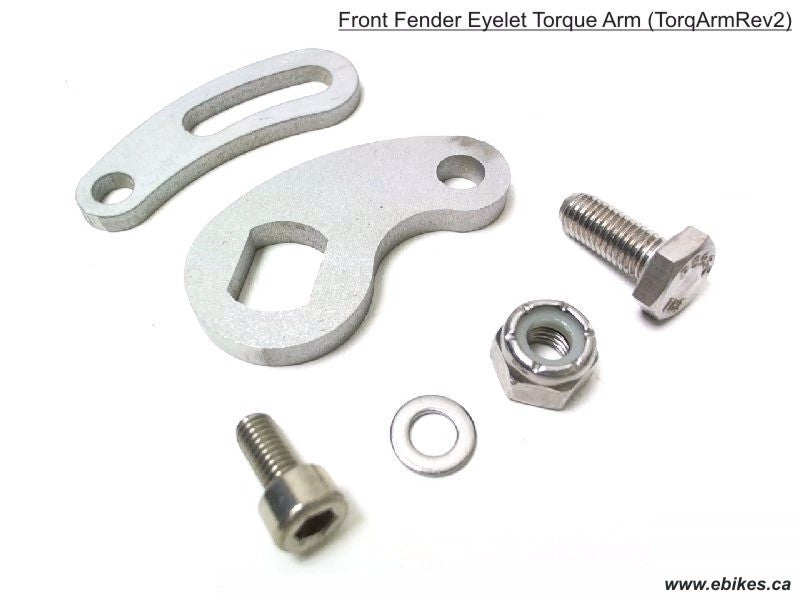Grin
GRIN Front Torque Arm V2 for mounting on forks with fender eyelets
$45.00
Torque arms are used to prevent axle rotation in hub motors. When a hub motor is powered up running, for all the torque that the motor generates spinning a wheel forwards, there is an equal and opposite torque on the axle causing it to rotate backwards.
In most electric bicycle hub motors, the axle is machined with flats on either side which key into the dropout slot and provide some measure of support against rotation. In many cases this is sufficient. However, in high power systems that generate a lot of torque, or in setups with weak dropouts, the forces present can exceed the material strength and pry the dropout open. When that happens, the axle will spin freely, wrapping and severing off the motor cables and potentially causing the wheel to fall right out of the bike.
To give a sense of the magnitude of these forces, a hub motor with a 12mm axle generating 40 N-m of torque will exert a spreading force of just under 1000lb on each dropout. A torque arm is a separate piece of metal attached to the axle which can take this axle torque and transfer it further up the frame, thus relieving the dropout itself from taking all of the stresses.
The Rev2 design was engineered to make use of the existing fender eyelet holes that are on most front forks. This can lead to a smaller arm and a tidier installation than using hose clamps around the fork, and we recommend its use whenever there is a suitable eyelet present.
Torque arms are used to prevent axle rotation in hub motors. When a hub motor is powered up running, for all the torque that the motor generates spinning a wheel forwards, there is an equal and opposite torque on the axle causing it to rotate backwards.
In most electric bicycle hub motors, the axle is machined with flats on either side which key into the dropout slot and provide some measure of support against rotation. In many cases this is sufficient. However, in high power systems that generate a lot of torque, or in setups with weak dropouts, the forces present can exceed the material strength and pry the dropout open. When that happens, the axle will spin freely, wrapping and severing off the motor cables and potentially causing the wheel to fall right out of the bike.
To give a sense of the magnitude of these forces, a hub motor with a 12mm axle generating 40 N-m of torque will exert a spreading force of just under 1000lb on each dropout. A torque arm is a separate piece of metal attached to the axle which can take this axle torque and transfer it further up the frame, thus relieving the dropout itself from taking all of the stresses.
Torque arms are used to prevent axle rotation in hub motors. When a hub motor is powered up running, for all the torque that the motor generates spinning a wheel forwards, there is an equal and opposite torque on the axle causing it to rotate backwards.
In most electric bicycle hub motors, the axle is machined with flats on either side which key into the dropout slot and provide some measure of support against rotation. In many cases this is sufficient. However, in high power systems that generate a lot of torque, or in setups with weak dropouts, the forces present can exceed the material strength and pry the dropout open. When that happens, the axle will spin freely, wrapping and severing off the motor cables and potentially causing the wheel to fall right out of the bike.
To give a sense of the magnitude of these forces, a hub motor with a 12mm axle generating 40 N-m of torque will exert a spreading force of just under 1000lb on each dropout. A torque arm is a separate piece of metal attached to the axle which can take this axle torque and transfer it further up the frame, thus relieving the dropout itself from taking all of the stresses.
Torque arms are used to prevent axle rotation in hub motors. When a hub motor is powered up running, for all the torque that the motor generates spinning a wheel forwards, there is an equal and opposite torque on the axle causing it to rotate backwards.
In most electric bicycle hub motors, the axle is machined with flats on either side which key into the dropout slot and provide some measure of support against rotation. In many cases this is sufficient. However, in high power systems that generate a lot of torque, or in setups with weak dropouts, the forces present can exceed the material strength and pry the dropout open. When that happens, the axle will spin freely, wrapping and severing off the motor cables and potentially causing the wheel to fall right out of the bike.
To give a sense of the magnitude of these forces, a hub motor with a 12mm axle generating 40 N-m of torque will exert a spreading force of just under 1000lb on each dropout. A torque arm is a separate piece of metal attached to the axle which can take this axle torque and transfer it further up the frame, thus relieving the dropout itself from taking all of the stresses.



